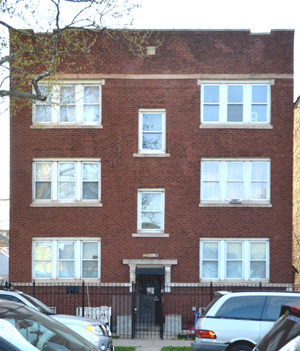Stuart Dybek’s Family Apartment Building

Floyd Sullivan, 2017
Stuart Dybek was born and raised in a Chicago Southwest Side port of entry neighborhood called Pilsen, a name that reflects the Czech immigrants who settled there in the 19th century. Dybek's grandparents on both his father's and his mother's side were Polish immigrants. His mother, Adeline, worked as a truck dispatcher and his father, Stanley, who was born in Poland, worked at the McCormick Works…
read moreStuart Dybek was born and raised in a Chicago Southwest Side port of entry neighborhood called Pilsen, a name that reflects the Czech immigrants who settled there in the 19th century. Dybek's grandparents on both his father's and his mother's side were Polish immigrants. His mother, Adeline, worked as a truck dispatcher and his father, Stanley, who was born in Poland, worked at the McCormick Works factory near 26th Street and Western Avenue. Stuart was born at St. Anthony's Hospital (2875 W. 19th Street) a hospital known locally as Holy Tony's. It's in a neighborhood called Douglas Park, which figures in Dybek's stories, "Hot Ice," "Song," and "Breasts," among others. The family lived in a bathroom-down-the-hall flat on 18th Street just off Blue Island Avenue in a building beside Czesky Salonsky Americky Hall Sokol on 1438 W. 18th, the site of Dybek's story "Chopin in Winter." Dybek attended St. Procopius School on 1641 Allport, which stands across the street from Thalia Hall, a building designed in imitation of a hall in Prague, that today houses the restaurant Dusek's, which is named after the architect. In the 50's Dybek's parents saved enough money to buy an apartment building on 2455 S. Washtenaw and the family moved there to an adjacent neighborhood known at Little Village. By then, a new wave of immigration from Mexico was taking place in Pilsen and Little Village which together came to be called the Barrio, one of the largest Hispanic neighborhood's east of East L.A. That new immigration figures prominently in many of Dybek's stories, such as the Nelson Algren Prize-Winning "Blight," and in a trilogy of fiction books that are set there: Childhood and Other Neighborhoods, The Coast of Chicago, and I Sailed with Magellan, and also Dybek's two volumes of poetry, Brass Knuckles and Streets in Their Own Ink. The move to Little Village required the family to switch parishes, from St. Procopius to St. Roman's on 2311 S. Washtenaw where Dybek went to grade school along with his younger brothers, David and Thomas. Little Village is a more industrial neighborhood than Pilsen and sites from that neighborhood such as the Cook County Jail on 26th and California and the Cook County Courthouse, and the Sanitary Canal with its bridges crossing California Avenue and Western Avenue, and the many viaducts, not to mention the taco joints and the bars and churches—St. Anne's, St. Paul's, St. Adalbert's—all figure in numerous stories and poems in Dybek's books.
After attending St. Rita High School on 63rd and Western (it has since moved) Dybek attended Loyola University on the Lake Shore Campus on the north side of Chicago—6300 N. Sheridan Rd—which would also figure in stories in the books Paper Lantern and Ecstatic Cahoots. He lived for several years in the neighborhood surrounding the university called Rogers Park and The Coast of Chicago opens there in a story called "Farwell" set on the street by the same name.








